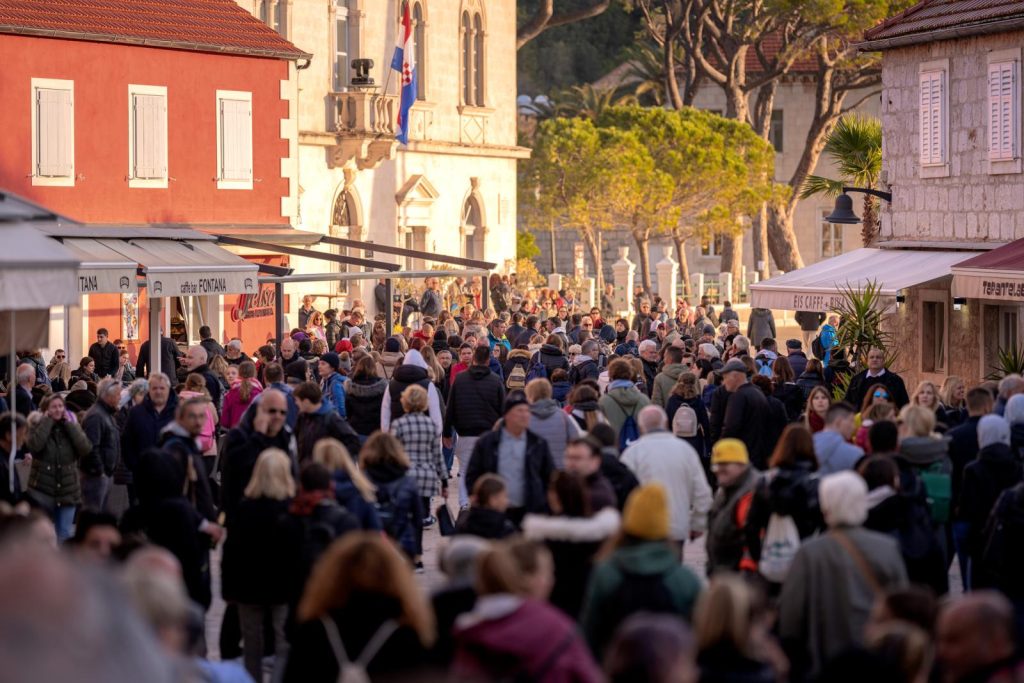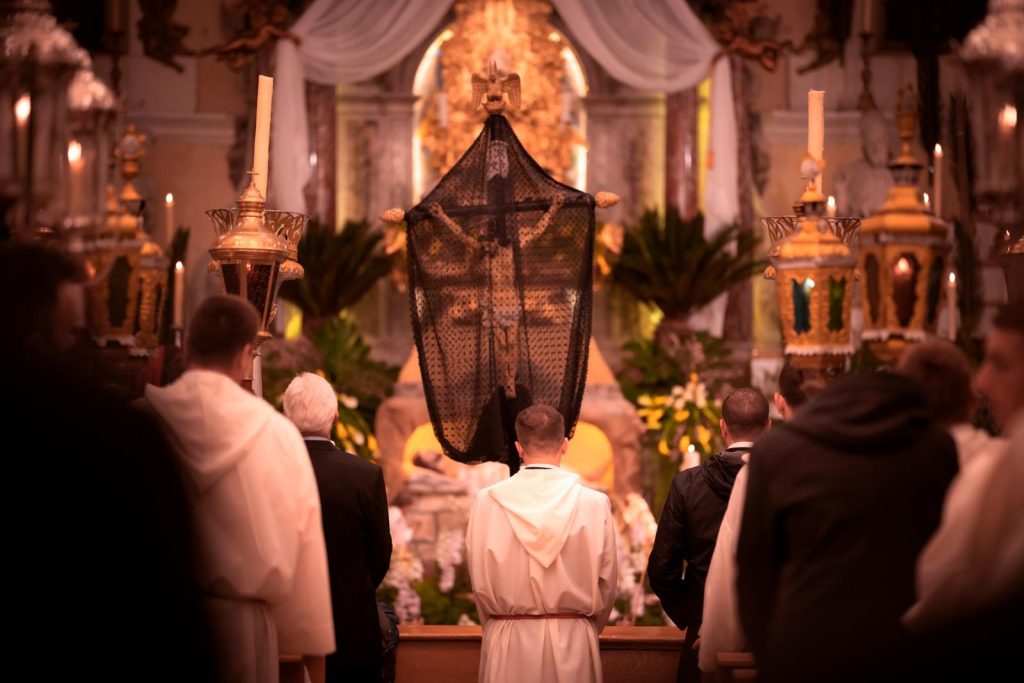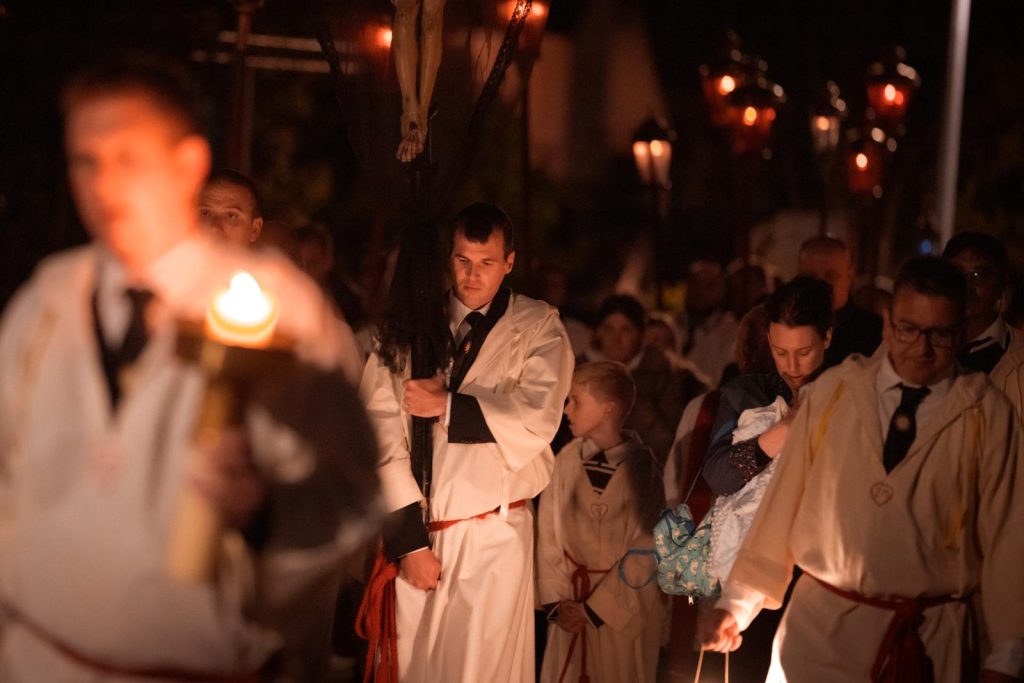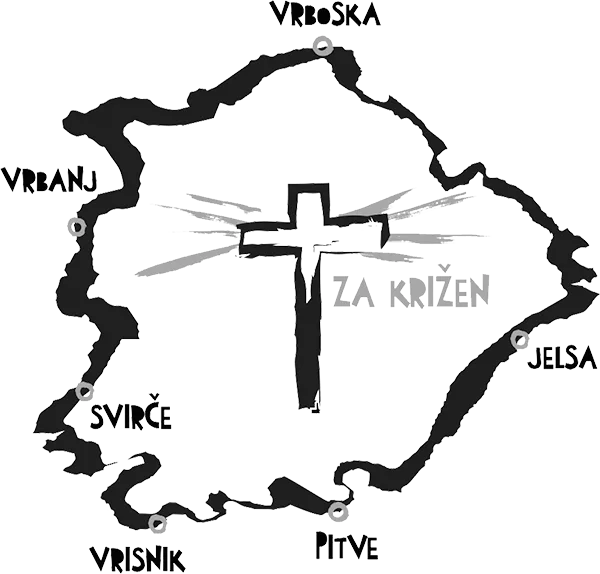Following The Cross Processions / A Guide
INTRODUCTION
On Hvar Island the past is always part of the present, carrying within itself the seeds of the future. The island teems with rich traditions, and in the period through Lent leading up to Easter there are poignant demonstrations of the depth of local religious beliefs expressed in music and pageantry.
Processions are a significant part of religious celebrations throughout the year, and never more so than during Holy Week. In the run-up to Easter there are two types of procession: the Theophoric processions, and the ‘people’s processions’. In the former, the first of which takes place on Palm Sunday, the parish priest carries a monstrance holding the Host, which represents the body of Christ. The ‘people’s processions’, in which a chosen volunteer carrying a large cross is leader, are organized by the lay confraternities without intervention from priests.

The ‘people’s processions’ are known as ‘Za križen’ (‘Following the Cross’), and take place all round Hvar, although the term is mostly associated with the all-night procession from Maundy Thursday evening to Good Friday morning in the central part of the island: six parishes take part, combining to form one great Procession experience out of six separate processions led by six Cross-Bearers. The one year when no ‘Za križen’ procession could be held on Hvar, in 1944 during World War II, it was held instead in the refugee camp at El Shatt in Egypt, where many people of Hvar had been evacuated.
ABOUT THE ALL-NIGHT ‘ZA KRIŽEN’ PROCESSION
The all-night ‘Za križen‘ Procession is a unique tradition which takes place every year during the night from Maundy Thursday to Good Friday, linking the settlements of Jelsa, Pitve, Vrisnik, Svirče, Vrbanj and Vrboska on Hvar Island. In the course of its extended history the Procession has defied wars, illnesses and pestilence, preserved by the faith and strength of the people of Hvar.

The continuity of this tradition is testament to the bond between this island’s inhabitants with their family, cultural and religious inheritance, as well as to their deep hopes for the times to come.
The ‘Za križen‘ Procession is highly picturesque, with the lay brothers of the confraternities in their robes carrying lanterns and torches under the moonlight as they make their way along the winding paths from village to village to each parish stop. It captures the soul of everyone who takes part.
Powerful spiritual events are not easy to describe in words. They carry within themselves a spiritual identity which is both visible and invisible, and which stretches across centuries. The spiritual experience transmitted by such events into the human soul lasts forever. The ‘Za Križen’ Procession is like a ‘living film’, in which six island settlements form an unbroken chain of prayer, piety and vows through the all-night pilgrimage. When it takes place, a special energy permeates the whole island. It is a fact that powerful spiritual traditions like the ‘Za Križen’ Procession are somehow magically unforgettable.

The Cross-Bearer from each parish is the central figure: each one of the six will have made a personal vow before taking up and carrying the holy cross, just as his forebears did before him over the centuries. All the six crosses go round the central area of Hvar Island in a heart-shaped route, spreading love, peace and blessings over each settlement and the island itself. The ‘Za križen‘ procession tradition on Hvar is extra special in that it has been taking place annually for more than 500 years.
It is for all these reasons that UNESCO included this invaluable tradition in the Representative List of the Intangible Cultural Heritage of Humanity.
From as far back as the Middle Ages the church confraternities took care of the people’s religious devotions, and they have continued to play a key part in organizing the ‘Za križen‘ Procession up to the present day. The tradition is linked into Holy Week as part of the Passion. The six processions set off simultaneously from each parish. As night falls, at 10 pm the pilgrims set off on their 24-kilometre walk from the parish churches in Jelsa, Vrboska, Vrbanj, Svirče, Vrisnik and Pitve. The route is circular, leading clockwise to each stop in the parish churches and chapels along the way, finishing at about 7 am in the home parish. The details of the route vary, as each parish has the right to choose which paths they take and which chapels they visit along the way.
Jesus’ suffering is reflected symbolically in the Cross-Bearer, whose cross, which he carries round the whole route, weighs between 10 and 20 kg. It is a demanding task, but at the same time an enormous honour, for which there is a long waiting list nowadays, in some parishes up to 20 years. It is often the case that the Cross-Bearers in any given year are following in the footsteps of their fathers or grandfathers who carried the Cross before them.
The start of the ritual send-off for each procession is signalled by a rattle, as no bells are rung from Maundy Thursday until the Vigil on Holy Saturday evening. The Cross-Bearers from the six settlements in the heart of Hvar Island set off barefoot or in socks. If socks are chosen, they are specially knitted in lambswool for the occasion: afterwards they are kept as a memento, and at the end of his life the Cross-Bearer is buried wearing them. Those who choose to carry the cross barefoot often do so as a mark of pushing their boundaries, or as part of their personal vow. The motivation behind each Cross-Bearer’s decision to take on the task is known only to the individual who has felt the invitation in his heart. The spur might be family tradition, a vow, an expression of gratitude or a prayer as a sign of unseen faith.
The Cross-Bearer is accompanied by a large group of selected supporters, predominantly friends and family. They are arranged in groups mainly according to their singing ability, the lead group walking in front of him, the others behind. They carry a variety of lanterns and candlesticks, the tallest red lanterns being at the front of the Procession. Two companions, often wearing dark suits rather than the confraternity robes, walk alongside the Cross-Bearer, ready to give a helping hand if needed. They are normally men who have previously carried the cross.
The Cross-Bearer is also responsible for choosing the singers of ‘Gospin plač‘ (‘Our Lady’s Lament’), who may walk round with the Procession, or go between stops by car. Two singers chant the main part of the lament, with three or four singing the response. They carry candles in their hands, which are lit or unlit according to parish custom. Although the Procession is organized by the laity, and is outside the normal Catholic rites, it is customary for each parish priest (if possible) to see off and welcome back his parishioners at the beginning and end of the Procession.

Many people join in the Procession, usually following the generally accepted convention that the males go first, followed by the females. At the beginning, the atmosphere is solemn, a feeling heightened by the darkness of the night and the sonorous harmonies of the ‘Gospin Plač’ lament in the churches and the chants and prayers which are sung along the route. As each Procession nears its destination the mood lightens as the dawn turns into day, bringing happiness and relief coupled with an almost cathartic sensation. At the end of the all-night pilgrimage in each parish church there is a final recital of the lament, prayers and concluding hymn, after which it is customary for everyone present to congratulate the Cross-Bearer. When all is concluded, the Cross-Bearer and his entourage go for breakfast followed by a rest, in preparation for the normal Catholic Good Friday rituals later in the day.
Uniquely, the Jelsan Cross-Bearer’s return to his home parish is dramatic, differing from all the others. After spending the whole night carrying one of the heaviest Crosses, he summons his last reserves of energy to sprint the thirty metres into Jelsa’s main square, where the parish priest is waiting to greet and embrace him. The Cross-Bearer falls on to his knees to receive the priest’s blessing, a touching scene which is always witnessed by a large crowd. When the Procession finally reaches the church, the parish choir puts on a concert of old Jelsan chants.
